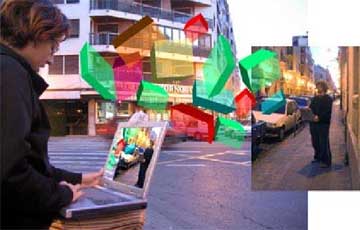Gestures control true 3D display
http://www.trnmag.com/Stories/2004/122904/Gestures_control_true_3D_display_Brief_122904.html
|
http://www.trnmag.com/Stories/2004/122904/Gestures_control_true_3D_display_Brief_122904.html
|
資料來源:交大建築所論壇

















Spanish researchers Clara Boj and Diego Díaz are working on the Free Network Visible Network , an augmented reality project which aims to make visible the exchanged information between computers of a wireless network.

First marks in the facades of the buildings will indicate the presence of a node, thus the possibility of connecting to the net, and at the same time to see the 3D representation of the information that we are interchanging with this node in real time.
Free game tools will then be developed that use the location of the players in the physical space as main element of the action development. For example, players would be able to modify the information (message, images or videos) on the marks placed in the physical space and record messages for other users / players. Or they would be able to change the publicity images or the urban signals by using small marks and creating game strategies.
Besides, the players will know in real time the position of other players if they are looking to a mark.
On the basis of these simple applications, users will be able to develop their own games.
--------------------------------
Free network Visible Network Project Homepage


相關工具:DART The Designer's Augmented RealityToolkit

昨天看到這篇文章,是由淡江的畢光建老師寫的,結尾這段相當不錯: